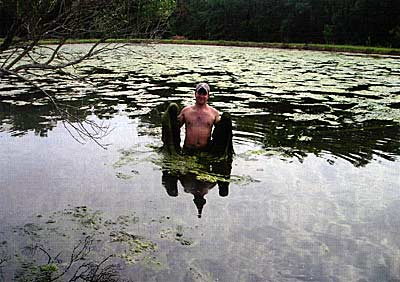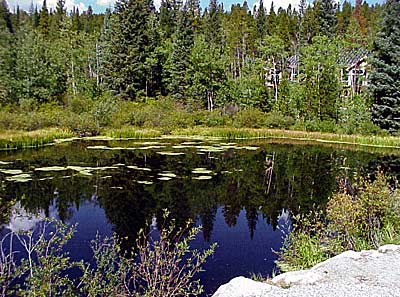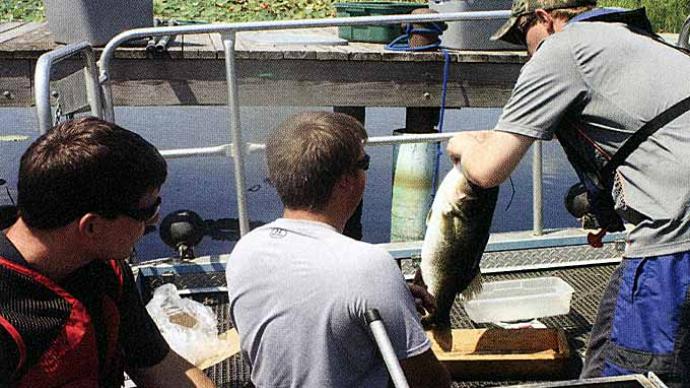
Throw off the cold blanket from Old Man Winter and prepare to welcome a new season. Days are getting longer each day, and you will soon see tiny buds on trees. Those buds will swell sooner than you think, and spring will break. We all love all those tender new shoots and the different shades of green as our property and its ponds spring to life.
Cedar waxwings are covering our cedar trees, doing what they do. Robins bounce around the yard, affirming our instincts that spring is here. Watching them poke around in the ground, grabbing worms, chasing slow-moving insects, and pacing together is a fun show.
Robins give a literal meaning to "early birds."
As stewards of your land and water, it's time to go through your checklist, ready to take every advantage Mother Nature offers as the temperature rises. You know just as sure as you put your heavy coat into storage and shove your wool socks to the back of the drawer, your pond will soon be the garden that grows all kinds of stuff, from native pondweeds to microscopic plankton, to neon green algae that seems to be the first stuff that pops up from the bottom each spring.
As soon as the water temperature strikes the tone of a speed zone, 55, Spirogyra erupts from the nutrient-laden bottom, spinning its thin angel-hair locks and flowing all over the food supply that has migrated into its favorite photic zone with last year's organic load and the most recent precipitation.
If it's not Spirogyra, it can be one of two or three dozen algae species.
Did you know snow is the biggest carrier of dissolved nutrients of any precipitation? Even more than rain. When snow sits on top of the ground, it can absorb all kinds of food for plants. That gives us food for thought. That stuff can collect phosphorus, nitrogen, and a variety of other micronutrients and then deposit that stuff straight into your pond as it melts. Since the surrounding bare ground isn't growing any grass yet this spring to bind some extraterrestrial nutrients, your pond or lake will be the leading receiver of these particulate matters.

Are you planning nutrient-binding treatments? If you plan to use aluminum sulfate or Phos-lock to do the trick, now is the time. Bind the stuff before plants grab it. So what is a nutrient-binding treatment, and what do you need to do?
Phosphorus, especially in northern ponds, is the primary culprit in the imminent explosion of greenery in your underwater world. If your goal is clarity in a pond, phosphorus must be rendered harmless through binding. So, test your water and see where your phosphorus numbers are. If your phosphorus exceeds 35 parts per billion (ppb), you have more than you need. To give you a perspective on this, one pound of phosphorus—enough to fill a one-pound coffee can, checks in at .37 parts per million (ppm) in an acre-foot of water. A pound of phosphorus in a quarter-acre pond that averages four feet deep has ten times more nutrients than needed to grow lots and lots of green stuff. In a bigger perspective, that same pound of phosphorus will grow 500 pounds of algae.
In southern ponds, many of us are accustomed to using phosphorus to create and perpetuate plankton blooms each spring. That's how we ensure our newly hatched baby fish have plenty of food to eat when rising off nests.
What's your take-home point? With too much phosphorus, you can wind up with that stringy greenery, and neither you nor your pond are happy. You won't see a plankton bloom without enough phosphorus dissolved in the water column.
It's a balancing act.
First, measure phosphorus via a water chemistry analysis at your favorite lab to decide whether you want to consider a nutrient-binding treatment. Do it now while the water is cool. Then, compare the amount of phosphorus to available nitrogen, and see if that ratio approaches 20 to 1 in favor of nitrogen. You are likely in a healthy balance if you have this ratio as a minimum and less than 35 ppb of phosphorus.
"Whoa!" you might be saying right about now, "what's all this dadgum water chemistry stuff? I'm not a scientist and don't understand this techno-jargon." The truth is, you don't have to be a scientist. It's not much different from trying to read the ingredients list of a recipe and then checking to ensure you have all the right stuff in the cabinet. However, if this seems outside your comfort zone, have your water tested, and pass those test results on to your nearest pond management professional, who will help you figure out what to do.
Water chemistry can be complicated, so pay attention to the most critical components. Look at pH, alkalinity, and phosphorus. Alkalinity is essential when considering whether or not to fertilize a southern pond or to evaluate if its role is to bind phosphorus. Then, compare your phosphorous to the available nitrogen, and you'll begin to see a correlation between those numbers and what grows in your water, how clear the water is, and what color your plankton bloom becomes.
This is the time of the year when you'll hear peepers, and you might see some salamanders getting ready to reproduce as they rustle through the leaves. You may see strips of tiny, coal-black eggs, bead-like in their appearance, in what looks like a glob of clear jelly. Watch them for a few days, and then you'll see little black tadpoles wiggling their way to livelihood. Those are the beginnings of little American toads.
What else is going on in your pond? Remember the majesty of your water and its physical properties. Water is most dense at 39 degrees F. Water at that temperature sinks to the bottom of your pond. For northern ponds, that means a layer of ice sat atop your pond this winter, and water at the bottom was at least 7 degrees warmer (and considerably less heavy) at the top than at the bottom. In the south, where ponds don't typically freeze, your water can be colder than water in northern ponds, sometimes separating those temperature layers similar to summertime stratification. That means your pond could have dimictic tendencies, meaning it can "turnover" twice a year, once in the spring and another time in the fall.
That leads to another item on your checklist—when to turn on your aeration system that was shut down last fall. Crank that machine on when water temperatures consistently push toward that double-nickel mark. I'll never forget the sage advice of an octogenarian fisheries biologist. He told me the white bass started running when the redbud trees bloom. That's the best time to find them moving up a river, preparing to spawn. That's also the best time to turn on your aeration system. Use the redbud trees as your signal.
Way back when, around 1980,I met fish farmer Bus Hartley from Kingman, Kansas. He's been credited as the first man to figure out how to spawn channel catfish and get the fry to survive in the United States. He was loaded with great advice for a green fisheries biologist. He once told me, "When the bullfrogs start croaking, largemouth bass are on the nests." Sure enough, I'd see bass on beds when the bullfrogs started serenading their love. That's another sign of rising temperatures and nature's signal to pondmeisters around the country to begin knocking things off your to-do list. Guess what temperature some of the invasive underwater aquatic plants begin to grow? Yep, you got it.
Even with the brisk chill of these early Spring mornings, you can be warmed by your thoughts and actions as you check each item on your pond's checklist. After all, when we follow nature's call and recognize that many of the decisions we make and much of what we do as pond managers are based around temperatures and temperature windows as nature awakens each spring. Pay attention to the temperature, make your plans, and your pond will respond in kind.
Reprinted with permission from Pond Boss Magazine



